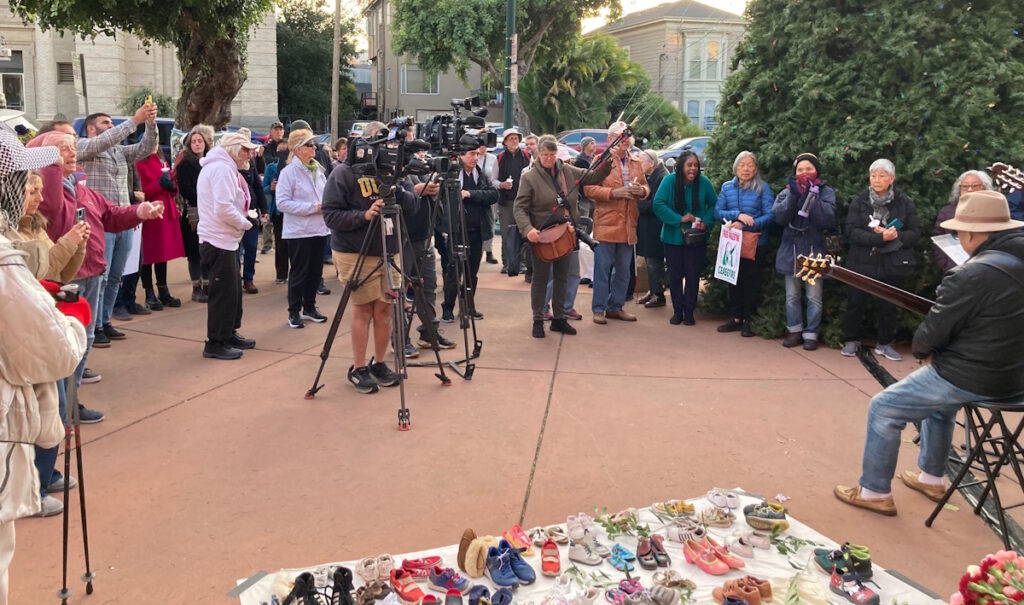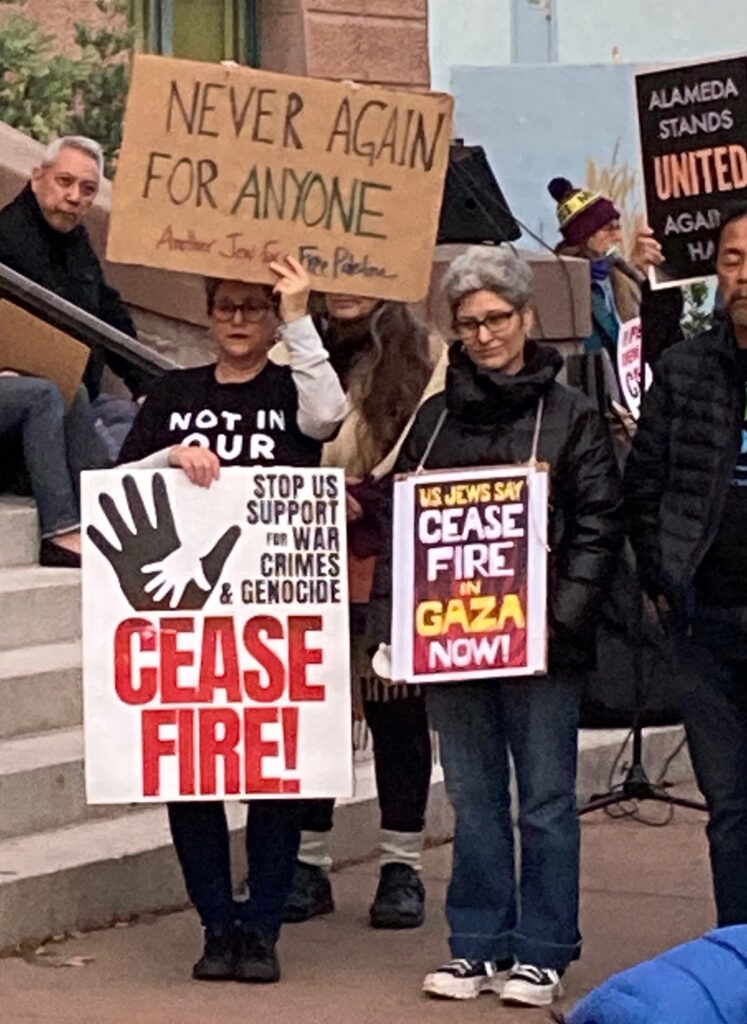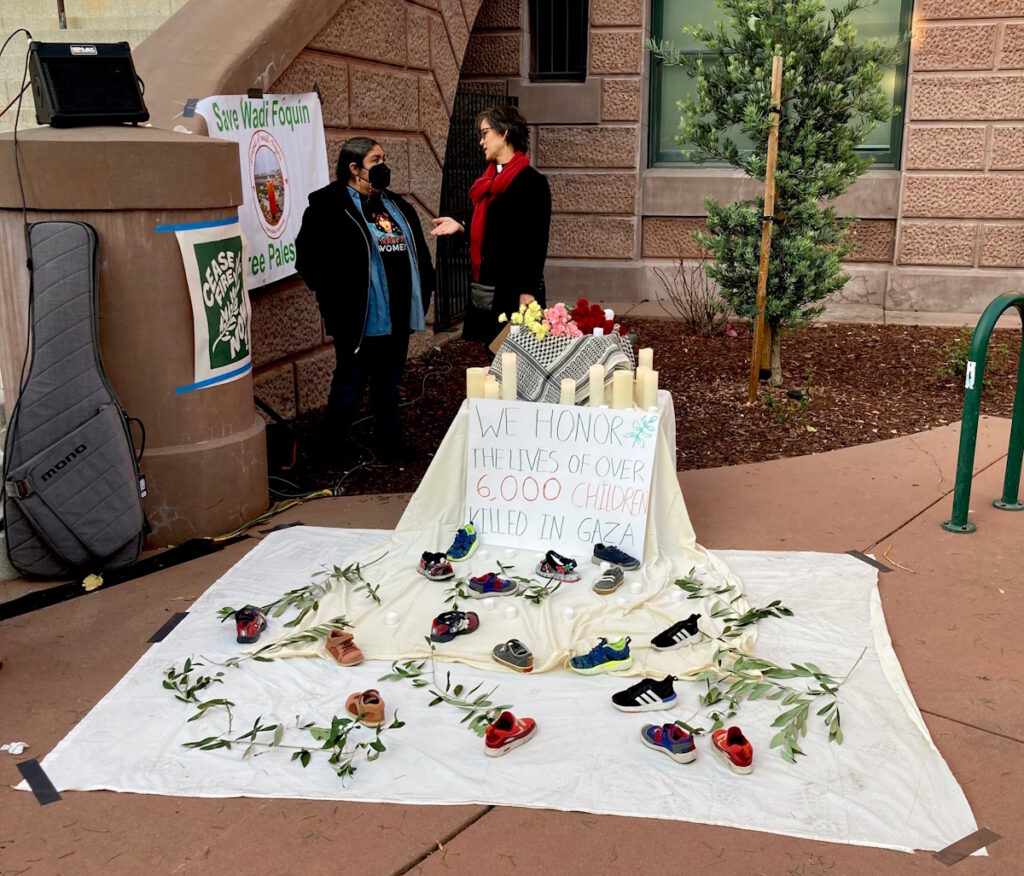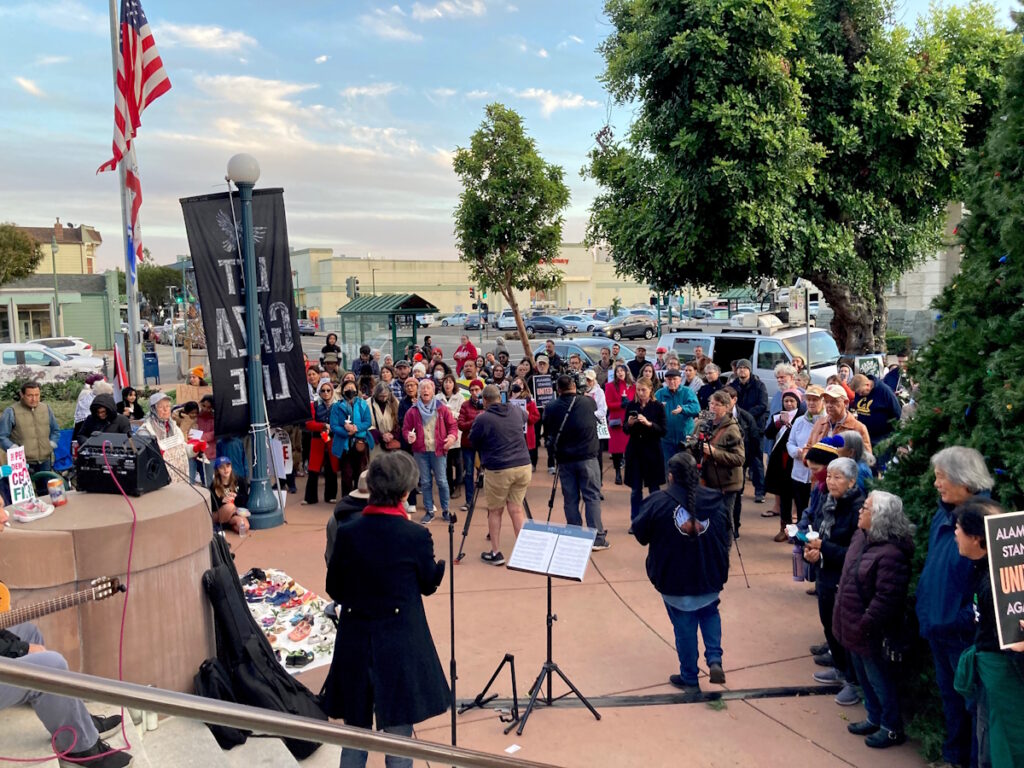An Estimated Hundred People Turn Out To Support Humanitarian And Political Causes

A peaceable assembly, calling primarily for an end to the bloodshed in The Gaza Strip and a permanent cease fire in the wake of the recent Hamas Israel war, brought together about 100 people in the plaza in front of Alameda’s City Hall on the evening of Sunday, November 26th.
The vigil’s overarching goals coincided with diplomatic efforts by Qatar, Egypt and The United States to extend the temporary cease fire in place at the time and extend it into a permanent one, a goal that Israel, thus far, has rejected in its resolve to eliminate Hamas.
The modest crowd –a mix of Muslims, Jews, Christians, men, women and children– held fast to a calm, composed and solemn demeanor that stood in stark contrast to the kinds of heated, vitriolic and sometimes violent clashes occurring in a host of cities and on university campuses around the nation and beyond.
Other key participants and speakers adding to the diversity of the assemblage were Jewish Voice for Peace Rabbi Lynn Gottlieb and Islamic Center of Alameda Imam Ariff Shaik.
The event’s setting provided another mix of sorts, with the dark silhouette of the City’s unlit Christmas Tree, flanked by two Pro-Palestinian banner towers, an “altar” blanket spread of about 60 pairs of children’s shoes arranged to symbolize an estimated 6,000 innocent civilian child casualties in Gaza since the most recent conflict broke out, a workshop table, and a temporary Muslim prayer mat.
The event was orchestrated primarily by Alameda Friends and Families For Cease Fire (AFFCF), an ad hoc community group of about eight to ten members, formed in the wake of the October 7 Hamas attack and kidnappings.
AFFCF planned the vigil in conjunction with Alameda’s Buena Vista United Methodist Church and affiliates, according to Laura Thomas, a leader of AFFCF, President of Alameda’s Renewed Hope Housing Advocates, and a retired career news reporter with multiple entities as The S.F. Chronicle, The Oakland Tribune and U.S. News and World Report magazine.
Thomas underscored the goal of the vigil’s call for a permanent cease fire, adding that “we wanted to show that Alameda has the same sort of moral grounding it has when it passed the sanctuary city” policy and “that the injustices the Palestinians have faced over the years be addressed in some way.”
“While I want a ceasefire as much as everyone here, I want more than that…I am hopeful that this current truce can be a foundation for future negotiations.”
Mayor Ashcraft, speaking as a private citizen
During the procession of various speakers who took to the microphone to give speeches, sing songs or lead prayers was Alameda Mayor Marilyn Ashcraft.
Speaking In her capacity as a private citizen, not an elected official –as the City has no official stance on the war– Ashcraft condemned “this endless cycle of violence (that) brings only futility and horror. While I want a ceasefire as much as everyone here, I want more than that. I want beyond that. I am hopeful that this current truce can be a foundation for future negotiations.
Tell President Biden we need to support not only a permanent ceasefire, but an independent Palestinian state,” she said. “We need to move beyond the horror,” she added as part of her speech which pointed out here Arab American heritage, time in The Middle East as a College student in Beirut and as a visitor to Gaza.
“Tonight, I stand before you as a resident of this city, as a citizen of the world,” she remarked.
The Mayor declined an interview request to elaborate on her views and experience at the vigil saying in her City e-mail that “My remarks at the vigil last night speak for themselves.”
“Mayor Ashcraft was in a tough position as a member of the political mainstream, The Democratic Party, and I’m sure she felt a lot of pressure,” with respect to expressing additional views said Thomas.
Other, written messages evident that crossed into more particularized political agendas were also part of the message mix at the vigil. One five-foot banner, attached to stantions, read, “Let Gaza Live.”
Another banner stated, “Stop U.S. Aid For Genocide,” a chest worn placard said “U.S. Jews Say Cease Fire In Gaza Now!” and another, with a more universal scope, read “Alameda Stands United Against Hate.”

Michael Yoshi, a retired minister with the Buena Vista United Methodist Church, spoke expansively about the vigil’s purpose and origins in an exclusive interview for this publication.
“This is not so much of a protest as much as it is a vigil to recognize and give dignity to the lives that have been lost in the last several weeks of the fighting in Gaza and for their families that are mourning “ in both Gaza and Israel.
Past the goal of honoring the dead and giving solace to their survivors, said Yoshi, is the call for a “permanent cease-fire” in hopes that doing so will “take us to look at the root causes” of the conflict.
ENTER: THE DEEP, COMPLEX BACKDROP OF HISTORY
At that point, Mr. Yoshi moved away from speaking of a common purpose, with which most all would agree, into a more viewpoint deterministic one, asserting that the tense, long standing, too often lethal, Palestinian/Israeli hostility lies in what he termed as “the long standing military occupation of Israel in Palestinian territory.”
Yoshi emphasized, objectively from the technical viewpoint of a nation-state historical perspective, that hostilities between Israelis and Palestinians have been going on since the partitioning of Palestine in 1947 by the United Nations to fulfill the aims of Britain’s Balfour Declaration of 1917.
In that document, Great Britain announced support during World War I that a “national home for the Jewish people” be created in what was then called Palestine, a region then under Turkish rule starting in 1516.
That U.N. “Partition” envisioned the eventual creation of two independent states, one Arab and one Jewish, under the jurisdiction of the UN as a “ trusteeship.”
The history underlying those minimal basics, and for which differing sides in the conflict share blame, is vastly more complex when it comes to a full understanding of “the roots” predating the UN action.
At any rate, Yoshi went on to say, from his perspective, that “ the important issue for those who have gathered here tonight is that Palestinians have rights to live, have rights to their land, have rights to their dignity.”
Yoshi suggested, given its role as a major power in the Middle East, that Israel needs to look at the matter from the moral question of “what does it see itself doing, and what kind of accountability in terms of their impact does it have ” on Palestinians and their lands?
Yoshi did not directly respond to questions as to whether or not an avenue towards a stable peace involves what has been termed the “two state solution” which Israeli Government leadership and Palestinian leadership agreed to in the early 1990’s, and to implement by the end of that decade.
That step towards peace and normalization of relationships, The Oslo Accords, brokered by U.S. President Bill Clinton, was hailed as a major peace breakthrough in 1993.
Extremists on the Palestinian and Israeli sides who opposed The Oslo Accords engaged in various political and lethal actions to sabotage it and set off a domino effect that would burn up the olive branch before long.
1994’s overlapping Jewish festival of Purim and Islam’s holy month of Ramadan saw a Jewish extremist, Baruch Goldstein fire upon Muslim worshippers in Hebron.
The militant organization, Hamas, which sparked this most recent and bloody war on Oct 7 of this year with its killing of over 1,200 Israelis and kidnappings of an estimated 236 persons –mostly civilians– launched a campaign in 1993 of six suicide bombing attack claiming 41 Israeli lives and wounding another 89, according to The Jewish Virtual Library.
Hamas, from its incipiency, has been a violent and vocal opponent of any two state solution, and it does not recognize Israel as a legitimate nation.
On its side, The Israeli Government, thus far, will not support the creation of an independent Palestinian nation, for which Ashcraft and others at the rally called.
Matters got worse in 1994 after a Jewish extremist killed Israeli Prime Minister Yitzhak Rabin, who signed the Oslo accords for his nation, unleashing political change in Israeli government leadership which opposes the two state solution which once seemed so close to becoming a reality– at least on paper.
After that, blood between Israelis, Palestinians and others continued to flow in an ongoing, reciprocal tragedy of history.
It’s time for people to ask, “what do I have that I’m proud to do to change the reality of the situation for the better, not only for the Palestinians and Israelis, but for themselves as well? ”
Yoshi
Yoshi essentially said that any move to reinvigorate a two state policy to take matters beyond a permanent ceasefire, would have to be up to Israel. “I can’t answer for them; that’s their question as most of Israeli society is not unified in their opinions.”
But at that brief time on a November evening, at that place in Alameda far from the war torn Middle East, the wisdom of the day seemed mostly about looking at matters from a standpoint of human compassion directed at producing a non- violent state of affairs.
A diverse group of locals came together to express and exchange their views and hopes, sing their songs, say their prayers or just participate through presence and contemplation of seeking a de-escalation of a conflict that extracts its daily toll on human rights and life for Gazans and Israelis alike.

—-
From another perspective, the vigil also manifested the great virtue of free political speech, prayer, and peaceful assembly in what was genuinely a non-violent gathering to help promote more of the same.
“It’s something people deserve to struggle with, and say, o.k., ‘what do I have that I’m proud to do to change the reality of the situation for the better, not only for the Palestinians and Israelis, but for themselves as well? ” said Yoshi.
Mayor Ashcraft resonated those sentiments in her speech to the gathering when she said, “For me, and I think for many of you, this is about humanity, about being able to see another’s suffering and understanding how we can contribute to alleviating it.”
As the vigil continued into the night,with candles offering illumination of hope, the American Flag at City Hall Plaza draped downward, in peaceful repose on its pole –a backdrop offering only an occasional touch of motion from passing breezes.

